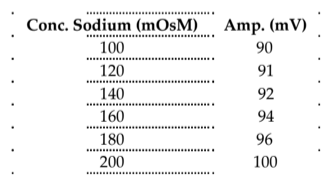The amplitude of an action potential depends in part on the amount of sodium in the extracellular fluid. Stanley Student has carefully impaled a neuron with an intracellular electrode. He tests the role of extracellular sodium by changing the concentration in the bathing fluid and recording an action potential after each change. The data he generated are shown in the table, where amplitude listed
is the peak amplitude of the action potential; make an appropriate graph.


Anatomy & Physiology
You might also like to view...
In males, meiosis involves ________ cycle(s) of cell division and produces ________ cells, or gametes, each containing 23 individual chromosomes.
A) one; four B) two; four C) one; six D) two; two E) four; four
Anatomy & Physiology
Oils are ________________________________________ at room temperature
Fill in the blank(s) with correct word
Anatomy & Physiology
The sebaceous glands are the ___ glands.
Fill in the blank(s) with the appropriate word(s).
Anatomy & Physiology
Which pattern of hormone secretion, represented by epinephrine, can have dramatic changes in its concentration and circulating levels?
A. Chronic hormone secretion B. Acute hormone secretion C. Long-term hormone secretion D. Episodic hormone secretion
Anatomy & Physiology